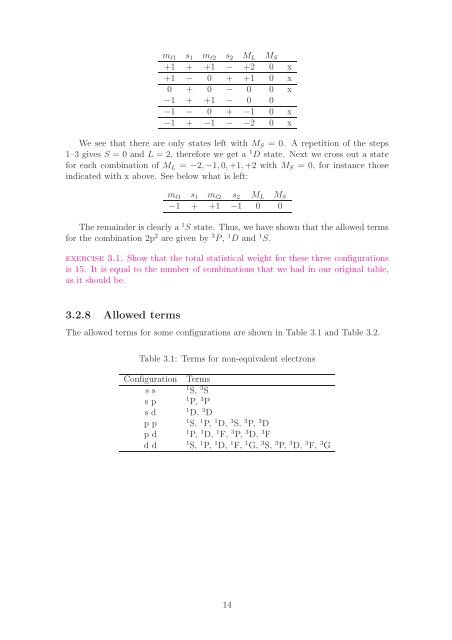Thermal X-ray radiation (PDF) - SRON
Thermal X-ray radiation (PDF) - SRON
Thermal X-ray radiation (PDF) - SRON
Create successful ePaper yourself
Turn your PDF publications into a flip-book with our unique Google optimized e-Paper software.
m l1 s 1 m l2 s 2 M L M S<br />
+1 + +1 − +2 0 x<br />
+1 − 0 + +1 0 x<br />
0 + 0 − 0 0 x<br />
−1 + +1 − 0 0<br />
−1 − 0 + −1 0 x<br />
−1 + −1 − −2 0 x<br />
We see that there are only states left with M S = 0. A repetition of the steps<br />
1–3 gives S = 0 and L = 2, therefore we get a 1 D state. Next we cross out a state<br />
for each combination of M L = −2, −1, 0, +1, +2 with M S = 0, for instance those<br />
indicated with x above. See below what is left:<br />
m l1 s 1 m l2 s 2 M L M S<br />
−1 + +1 −1 0 0<br />
The remainder is clearly a 1 S state. Thus, we have shown that the allowed terms<br />
for the combination 2p 2 are given by 3 P, 1 D and 1 S.<br />
exercise 3.1. Show that the total statistical weight for these three configurations<br />
is 15. It is equal to the number of combinations that we had in our original table,<br />
as it should be.<br />
3.2.8 Allowed terms<br />
The allowed terms for some configurations are shown in Table 3.1 and Table 3.2.<br />
Table 3.1: Terms for non-equivalent electrons<br />
Configuration<br />
s s<br />
s p<br />
s d<br />
p p<br />
p d<br />
d d<br />
Terms<br />
1 S, 3 S<br />
1 P, 3 P<br />
1 D, 3 D<br />
1 S, 1 P, 1 D, 3 S, 3 P, 3 D<br />
1 P, 1 D, 1 F, 3 P, 3 D, 3 F<br />
1 S, 1 P, 1 D, 1 F, 1 G, 3 S, 3 P, 3 D, 3 F, 3 G<br />
14
















